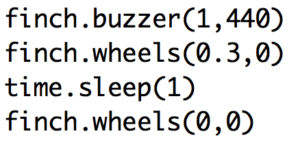The last Finch output is the buzzer. You can use two methods to play a tone on the Finch’s internal buzzer: buzzer() and buzzer_with_delay(). Both of these methods require two parameters. The first is the duration of the sound in seconds.The second parameter is the frequency of the sound; keep in mind that humans can only hear sounds in the range of 20 to 20,000 Hz.
The buzzer() method will start the buzzer and then immediately move on to the next line of code. The buzzer_with_delay() method, on the other hand, will pause the program until the sound is done before moving to the next line of the program.






